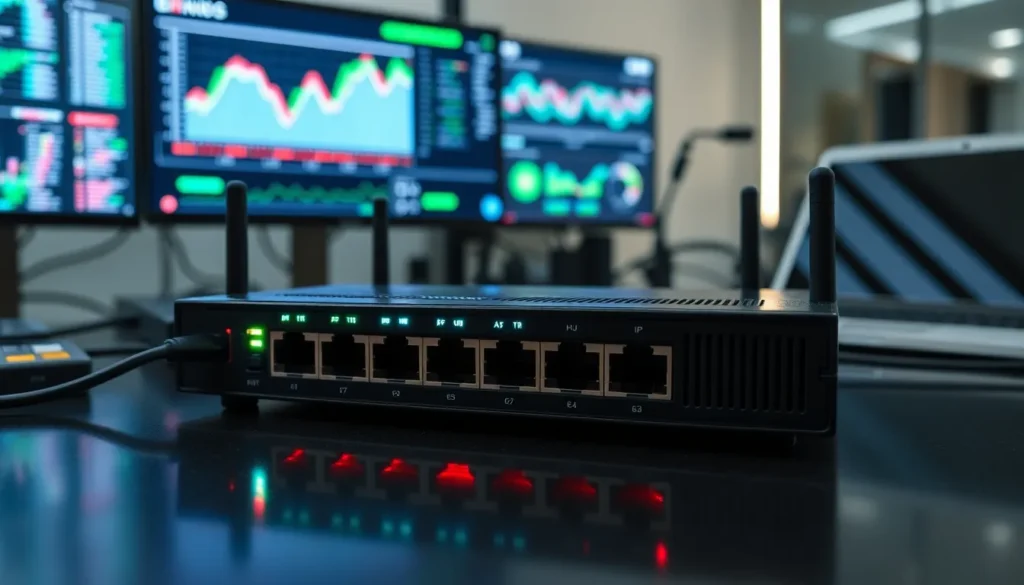Table of Contents
ToggleIn the world of networking, understanding IP addresses is crucial for effective communication and connectivity. The string “172.16.252.214.4300” may seem like a jumble of numbers at first glance, but it holds significant meaning in the realm of private networks. This address is part of a reserved range, often utilized in local area networks (LANs) to facilitate seamless data exchange among devices.
As technology advances, the need for efficient network management becomes ever more critical. Exploring the implications of this specific IP address can shed light on how networks operate, the importance of addressing schemes, and the potential for improved security measures. Delving into the details of “172.16.252.214.4300” reveals not just its technical aspects but also its role in the broader context of network infrastructure.
Overview of 172.16.252.214.4300
The address “172.16.252.214.4300” represents an atypical structure for an IP address, as it combines an IPv4 address with an additional port number. The base portion, “172.16.252.214,” resides within the private IP address range defined by RFC 1918. These addresses serve functions in local area networks (LANs), enabling devices to communicate internally without using public IP space. The segment “4300” indicates a port number, suggesting that this address might interact with a specific network service or application.
Key Characteristics
- Private Addressing: 172.16.252.214 follows the private addressing scheme, allowing organizations to reserve public IP addresses and manage internal communication effectively.
- Port Utilization: The inclusion of 4300 denotes an open communication line for an application layer protocol, facilitating services like web hosting or database access.
- Network Security: Understanding the use of such addresses bolsters security strategies by allowing network administrators to monitor traffic and implement firewalls effectively.
Practical Applications
- Internal Communications: Devices assigned the address can communicate securely within internal networks, optimizing data transfer.
- Service Specification: The port enables connections to specific services, like HTTP or FTP, based on organization needs.
- Network Management: Administrators can configure security protocols to detect and analyze traffic from this address, enhancing overall network performance.
This overview emphasizes the function and significance of 172.16.252.214.4300 within networking contexts, providing a foundation for deeper discussions on its implications for network architecture and security.
Technical Specifications

The address “172.16.252.214.4300” serves as an example of important technical specifications in network communications. This section delves into the specifics of the IP address and the port information associated with it.
IP Address Explanation
The IP address “172.16.252.214” is classified as a private IPv4 address according to RFC 1918. This classification restricts its usage to local area networks (LANs), facilitating confidential communications among devices. Within the range of private IPs, this address supports efficient data transfers without consuming public IP space. The 172.16.0.0/12 subnet includes addresses from 172.16.0.0 to 172.31.255.255, offering a substantial pool for internal network configurations.
Port Information
The segment “4300” signifies a port number that designates a specific communication endpoint for applications using the IP address. Port numbers enable multiple services to operate on the same IP address concurrently. In this instance, port 4300 could be allocated for specialized network services, such as file transfers or custom applications. Depending on the configuration, this port might require certain firewall rules or access control configurations to ensure secure communication and prevent unauthorized access. Port assignments typically align with standardized service protocols or can be custom-defined depending on the application’s requirements.
Use Cases and Applications
The IP address “172.16.252.214.4300” serves various applications within a network. Its role is crucial in both networking scenarios and security implications that enhance infrastructure efficiency.
Networking Scenarios
- Internal Communication: Organizations utilize “172.16.252.214” for secure, private communication between devices on the same local network without exposing data to the outside world.
- Service Hosting: The port “4300” allows specific applications to operate on this IP, facilitating services like web hosting, database management, or file sharing.
- Traffic Management: Network administrators monitor data flow through this address and port, employing traffic analysis tools to optimize performance and identify bottlenecks.
- Virtual Private Networks (VPNs): This IP configuration works well for VPN setups, ensuring encrypted connections for remote workers accessing internal resources.
Security Implications
- Firewall Configurations: Properly configuring firewalls for “172.16.252.214.4300” secures the network from unauthorized access and maintains data integrity.
- Access Control: Implementing strict access controls on this IP and its designated port ensures only authorized users and applications communicate over the network.
- Intrusion Detection: Monitoring activities on this address assists in early identification of potential security threats or breaches, enhancing overall network resilience.
- Segmented Networks: Using this IP facilitates segmentation of different network areas, isolating sensitive data and improving overall security posture.
Performance Evaluation
Performance evaluation of the IP address “172.16.252.214.4300” considers speed and reliability, influencing network efficiency and user experience.
Speed and Reliability
Speed of communications through “172.16.252.214.4300” largely depends on the underlying network infrastructure and application demands. Latency affects data transfer rates, while bandwidth availability supports the volume of concurrent communications on this address. Utilizing this private IP in a LAN typically offers lower latency and higher speeds due to minimized external routing and reduced congestion. Reliability emerges from the consistent internal addressing scheme, fostering stable connections for applications utilizing port 4300. Network practices such as Quality of Service (QoS) might further prioritize critical traffic, ensuring vital applications maintain performance even during peak loads.
Comparison with Alternatives
Comparison with alternative IP configurations emphasizes the advantages of using “172.16.252.214.4300.” Other private addresses, such as 192.168.x.x or 10.x.x.x, offer similar benefits for internal communications but may not provide the same addressable range or specifics for certain applications. The unique combination of port 4300 on this IP simplifies service hosting while ensuring privacy and security are maintained. This setup contrasts with public IP addresses, which expose services to potential external threats, highlighting the security advantage of using a private address for sensitive internal applications. Focusing on this particular configuration usually results in enhanced performance, security, and efficient network management compared to less optimized alternatives.
Understanding the intricacies of “172.16.252.214.4300” can significantly enhance network management and security. This private IP address combined with its port number offers a unique opportunity for internal communication and service hosting. It plays a crucial role in ensuring efficient data exchange while maintaining confidentiality within local networks.
By implementing proper firewall rules and access controls, networks can safeguard against unauthorized access while optimizing performance. The insights gained from this address not only facilitate improved traffic management but also contribute to a more secure network environment. Overall, “172.16.252.214.4300” exemplifies the importance of thoughtful IP address utilization in modern networking practices.



